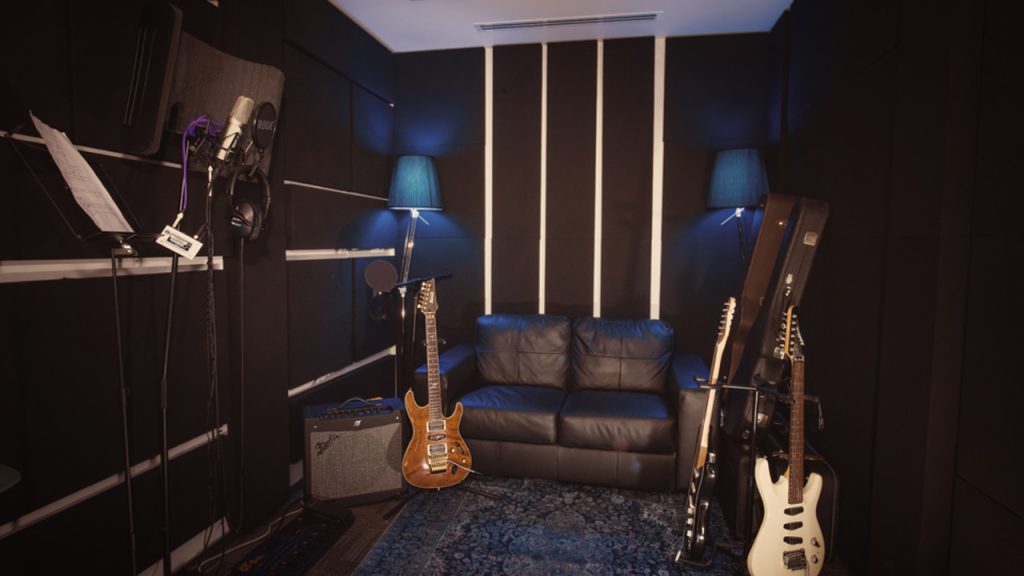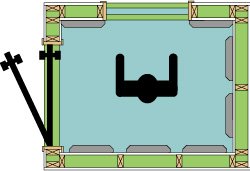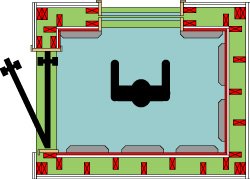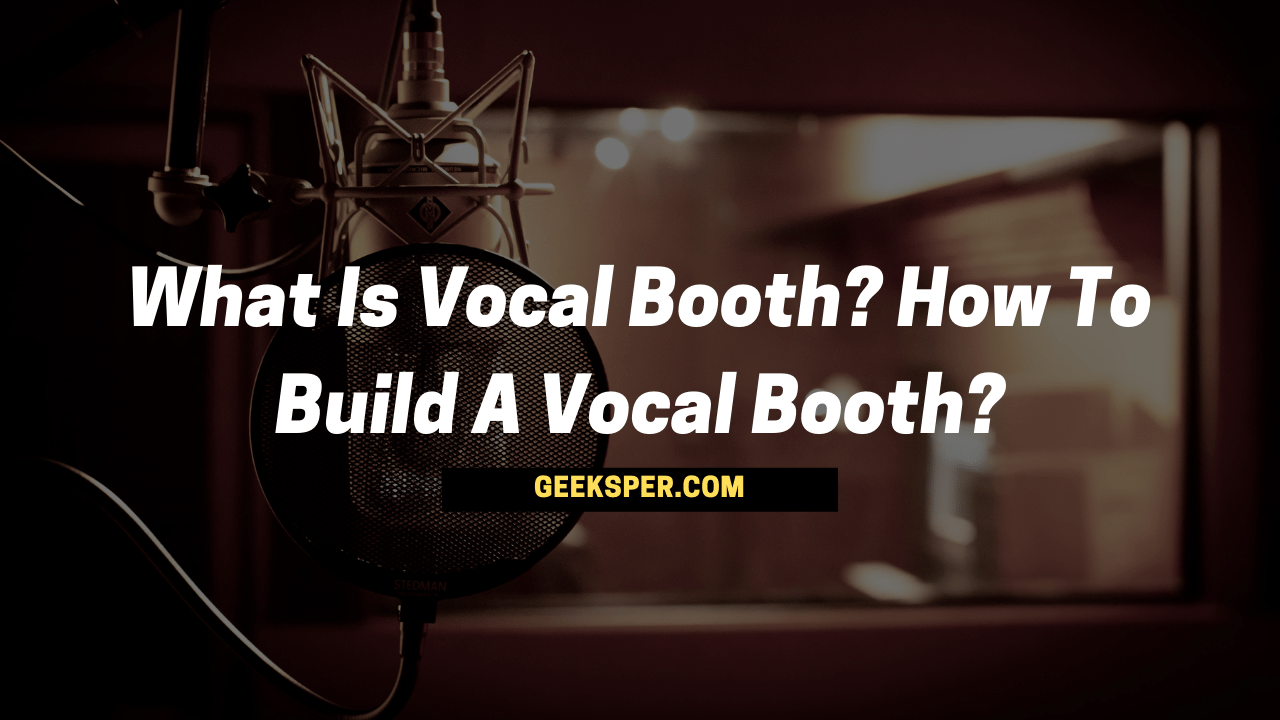Are you looking to build a vocal booth? Then you are in the right place!
A vocal booth is an enclosed area that reduces echoes, room reverberation, and shields out unwanted noise to better sounding audio recordings. This is an essential studio recording accessory because it provides the perfect space for singing or podcasting.
In this blog post, I will discuss the various types of vocal booths, how to build a vocal booth.
What Is Vocal Booth Exactly?

A vocal booth is a room that cancels echoes, decays, and noise while simultaneously protecting the recording from unwanted sounds.
This term is comparable to the photographic term “booth.” This recording space is generally built with soundproofing materials, much like a photo booth. These materials are utilized inside the vocal booth to minimize noise pollution from the outside world.
While recording, you want to limit any outside interference. The best way to do this is by creating a vocal booth that absorbs, reflects or blocks any outside noise.
Here are some of the most common vocal booth types that you can build yourself:
Why Build a Vocal Booth?




The sound of your voice is influenced by the space you sing in. If you are singing in an untreated room, it can produce wild reverb and get very echoey. If you are recording vocals in the room, then it will pick up all sorts of noise, which will be recorded on your recording.
The best way to avoid all this is by building a vocal booth and singing in it. Then, once you like the sound of your voice in your recorded files, you can record in any room and know that it will sound good.
It’s important to note that since we cannot stop echoes from happening, our goal is to control them. We can do this by using sound-absorbing materials to knock them down a notch.
How to Build the Best Vocal Booth?
So, what is the best way to build a vocal booth that sounds good but will not bust your budget? For starters, you can use things around your house. Here are some tips on how to make the most of it:
If you have an empty room in your house or apartment, all you need is a few acoustic panels to turn it into a great sounding vocal booth.
The first thing you need to do is soundproof the walls so that no noise from outside seeps in through the wall. Once the room is sealed, you can install 1 or 2 acoustic panels on each of the four walls. The type of panel you should use depends on the sound you are trying to control.
Determining the size of the room

Some rooms are for talking. These rooms are smaller so they can have one or two people in them. Other rooms are for drums, guitars, and other instruments. These rooms need to be big enough to have these things in them. The size of a vocal booth is usually 3′ x 4′ to 4′ x 6′ in size. (92cm x 122cm to 122cm x 155.5cm)
| Room Dimension | Metric | Resonance |
|---|---|---|
| 8 feet | 2.44 meters | 141 Hz |
| 7 feet | 2.13 meters | 161 Hz |
| 6 feet | 1.83 meters | 188 Hz |
| 5 feet | 1.52 meters | 226 Hz |
| 4 feet | 1.22 meters | 283 Hz |
| 3 feet | 0.91 meters | 377 Hz |
Wall and floor construction



If you want to build a room inside of the studio, then you should put it in a different room. It would be best if you also put rubber things under the floor not to shake.
Wall and ceiling construction can be made with different levels of isolation. With one layer of gypsum board on each side, it would be the minimum.
You can make walls more soundproof by putting another layer of material on the wall. Sound is energy, and if you put more mass on the wall, it takes more energy for the sound to vibrate and pass through.
Materials For Constructing your vocal booth
The denser the material, the better its soundproofing quality. Let’s look at the essential materials you will use:
- Timber – good quality pine or heavier
- Acoustic plasterboard
- Rockwool
- Acoustic mastic
- Solid wood door
- Neoprene door seal
- Acoustic tiles
Steps to Construct Vocal Boot in Your Home
Now that you know the materials that you will need to construct your vocal booth, how do you go about doing it? Here is a list of steps.
1. Selecting the right absorptive panels for the walls
Vocal booths can be made of anything on the inside. But what you put on the outside will determine how good they are at blocking sound. You must use an effective soundproofing material.
2. Constructing The Frame
The frame is the support structure that gives the booth its shape. You can use wood, steel or a combination of both. The two most commonly used materials are 16-gauge C-channel and galvanized steel conduit.
3. Installing insulation in your vocal booth
There are many different types of insulation you can use. The most common choice is fibreglass. Rockwool is also popular. Fibreglass insulation works best in smaller booths (like the ones you see at home studios). If you are building a larger booth, then go for Rockwool instead.
4. Constructing the door frame and hanging the door
The door frame should be made of wood, and it should be sturdy. The door is the most crucial part of any vocal booth. It must block out noise while being easy to open.
Most doors are made from solid wood with a thickness of at least 1″ or 2cm. You can use plywood instead if you want, but make sure that it has at least 3 layers.
5. Installing the window
If your studio does not have a window, you need to put a glass pane in the door. This will allow enough light into the booth while still letting through sound. If your studio does have a window, use acoustic grade plywood when constructing the walls and seal off any gaps around it.
In addition to this, make sure that you add double-paned glass to the window. For better sound insulation, use two panes of 1/2″ (12mm) thick glass with an air gap between them.
6. The Ceiling
You can install a grid ceiling or build one from scratch if you want to save money. A grid ceiling is very easy to make. To make a grid ceiling, you attach furring strips to the metal frame and stretch 1/4-inch (6mm) wire mesh over it.
7. Painting your vocal booth
To get rid of any echo or reverb, paint all interior surfaces with sound-absorbent paint. If you have a good vocal booth, then most of the time, you will not need to use any sound treatment at all inside it.
8. Putting it all together
Once everything is done, just put the booth in your studio and adjust it until you find that perfect sweet spot. Below are some images of how a vocal primer and at least two coats of sound-absorbent paint can help to give you a good sounding vocal booth.
Types of Vocal Booths
Three Types of Vocal Booths Available on the Market
1) Permanent Vocal Booth
This is the basic and most efficient setup. The construction follows the same procedure as stated before, but it can be placed in an isolated room or your home with a power supply and flooring for convenience.
2) Portable Vocal Booth
It can be carried anywhere you need to use it and set up almost instantly without any hassle. It uses the same construction as the permanent booth but is made of more lightweight materials and can be easily moved.
3) Temporary Vocal Booth
This setup is usually used by singers who go from one studio or producer’s home to another. The construction follows the same procedure as stated before, but this type of booth is also transportable. It only takes a little more time to set up but can be rebuilt easily.
4) DIY Vocal Booths
I’ve seen several people asking about how they can build their vocal booth or where they can buy one online for lower prices. After doing some research, I found that it is possible to build your own without too much hassle and can be done for a relatively low cost.
5) Modular Vocal Booths
More expensive than a DIY booth or portable, but provides better sound quality and insulation for much longer. If you plan to record in the same space all the time, this option would be great for you.
FAQs (Frequently Asked Questions)
What is a vocal booth?
A sound or isolation booth is a small room within a recording studio designed to have practically no reverberation and little or no sound leakage. The purpose of the vocal booth is to isolate your recorded vocals from any other sounds in the studio. This will provide you with much cleaner sounding recordings.
How much will a vocal booth cost to build?
The prices vary on where you buy the materials and how expensive the wood is, but if you already have some of this stuff laying around, it can cost as little from starting $500; it is not exact, and it can be more if you go with a lovely wood finish.
What does a vocal booth look like?
The shape and size of the vocal booth will vary depending on your personal preference and what you want to use it for. An ideal vocal booth is not too large but still big enough to provide you with plenty of room to move.
Conclusion
If you want to get the best recording quality in your studio/home, then building a vocal booth is essential. You can always go to an acoustics specialist or friend who has worked with them before and ask for some advice when designing yours.
If you are serious about your recordings, then I recommend taking time to build a good booth that will give you the desired results.
I hope this article has been helpful on how to build a vocal booth.
Until then check out some of my other articles too:
How to use a USB microphone on Xbox One?
How To Hold a Microphone In Detail
How To Use Bluetooth Karaoke Microphone?
How to Make Blue Snowball Sound Better?
How to adjust microphone sensitivity?
